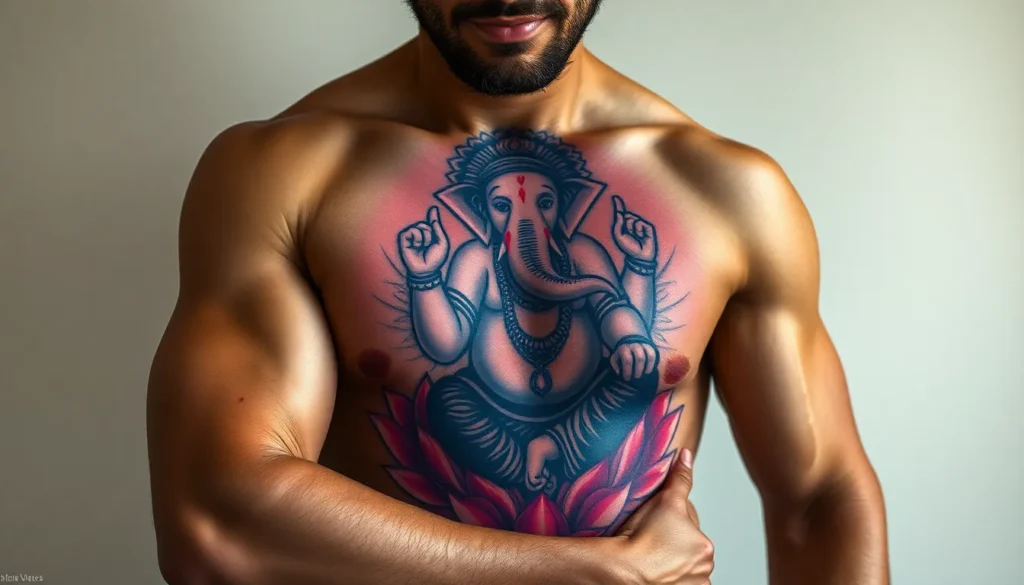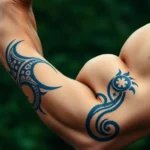Bold spiritual ink meets masculine artistry when we explore the captivating industry of Ganesha tattoo designs for men. These powerful tattoos aren’t just body art – they’re sacred symbols that represent wisdom, prosperity, and the removal of life’s obstacles. Whether you’re drawn to traditional Indian motifs or modern interpretations, Ganesha tattoos offer men a meaningful way to express their spiritual journey.
We’ve witnessed an incredible surge in popularity for these divine designs among men seeking tattoos with deeper significance. From intricate sleeve pieces featuring the elephant-headed deity in full glory to minimalist geometric interpretations, the versatility of Ganesha tattoos appeals to every style preference and personal belief system.
The beauty lies in customization – we can incorporate elements like lotus flowers, om symbols, or mandala patterns to create a truly unique piece that resonates with your individual story. Ready to discover the perfect Ganesha design that’ll transform your vision into stunning reality?
Traditional Ganesha Tattoo Designs for Men
Traditional Ganesha tattoo designs for men draw from centuries of Hindu artistic heritage, featuring authentic elements that honor the deity’s sacred symbolism. These timeless designs remain popular choices for men seeking meaningful body art that connects them to spiritual traditions.
Classic Sitting Pose Variations
Sitting pose variations showcase Ganesha in his most recognizable meditative positions, each carrying distinct spiritual meanings. We often see the classic lotus position where Ganesha sits cross-legged with his trunk gracefully curved to one side. This traditional pose represents inner peace and spiritual contemplation.
Sukhasana position depicts Ganesha sitting comfortably with legs folded, often holding his favorite modak sweets in one hand. Artists frequently incorporate intricate details like ornate jewelry, flowing robes, and decorative cushions beneath the seated figure. The relaxed posture symbolizes accessibility and approachability of divine wisdom.
Regal throne variations present Ganesha seated on elaborate carved thrones or lotus pedestals, emphasizing his status as the remover of obstacles. These designs typically feature detailed architectural elements, flowing fabric drapes, and ceremonial objects surrounding the central figure. Traditional artists often add royal insignia and crown details to enhance the majestic appearance.
Sacred Symbols and Elements
Sacred symbols in traditional Ganesha tattoos include the Om symbol, lotus flowers, and geometric patterns that amplify spiritual significance. We commonly incorporate the conch shell, which represents the sacred sound of creation, positioned near Ganesha’s hands or floating around the main design.
Ritual objects like the modak, trishul, and prayer beads add authentic elements that devotees recognize immediately. The broken tusk often appears prominently, symbolizing sacrifice and the importance of keeping one’s word. Artists frequently include the mouse companion Mushika at Ganesha’s feet, representing the conquest of ego and desire.
Mandala backgrounds create intricate circular patterns that frame the deity, combining geometric precision with spiritual symbolism. These detailed backgrounds often feature repeating motifs, floral elements, and Sanskrit characters that enhance the overall sacred aesthetic. Traditional color schemes emphasize deep oranges, rich blues, and golden accents.
Hindu Iconography Integration
Hindu Iconography Integration combines multiple deities and religious symbols to create comprehensive spiritual narratives within the tattoo design. We often see Ganesha paired with other Hindu gods like Shiva or Parvati, creating family representations that tell deeper mythological stories.
Temple architecture elements include ornate pillars, carved doorways, and decorative arches that frame the central Ganesha figure. These architectural details reference actual Hindu temple designs, adding authenticity and cultural depth to the tattoo. Artists incorporate traditional building materials like stone textures and metallic finishes in their shading techniques.
Sanskrit calligraphy adds meaningful mantras and prayers in traditional Devanagari script, often flowing around the main design elements. Popular choices include “Ganpati Bappa Morya” and “Om Gam Ganapataye Namaha” written in elegant, flowing letterforms. The integration of sacred text with visual elements creates a complete spiritual expression that resonates with traditional Hindu worship practices.
Modern Minimalist Ganesha Tattoo Styles
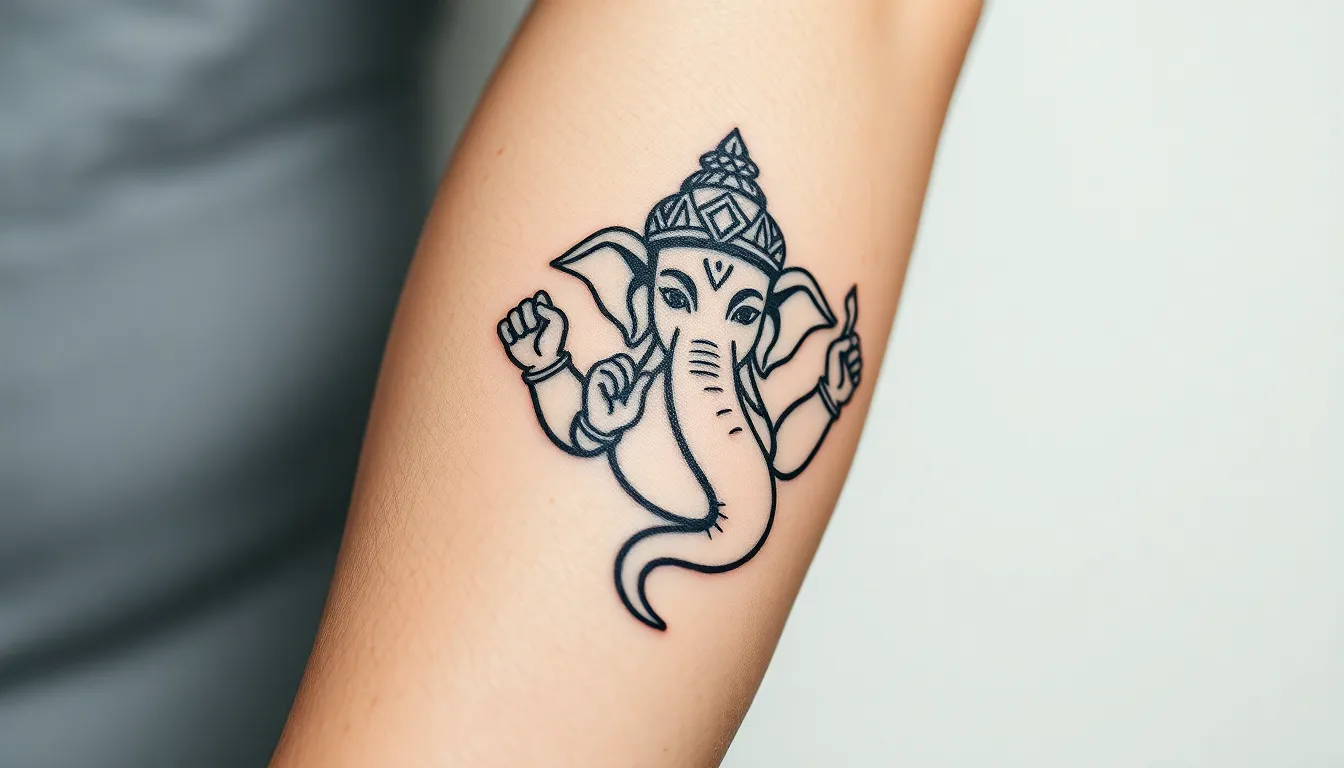
Modern men increasingly embrace minimalist Ganesha designs that balance spiritual meaning with contemporary aesthetics. These refined tattoos offer subtle elegance while maintaining powerful symbolism.
Line Art Interpretations
Line art Ganesha tattoos capture the deity’s essence through continuous or single-line drawings that emphasize simplicity over detail. We’ve observed how these designs focus on key features like the distinctive trunk, ornate crown, or expressive eyes to create instantly recognizable silhouettes. Artists often use flowing, unbroken lines to outline Ganesha’s form, creating a meditative quality that reflects the spiritual journey of obtaining wisdom and removing obstacles.
Clean execution becomes crucial in line art interpretations since every stroke must serve a purpose. These tattoos work exceptionally well on forearms, wrists, and necks where the simple lines can follow natural body contours. The minimalist approach allows for versatile placement options while maintaining the powerful symbolism associated with Lord Ganesha as the remover of obstacles and god of beginnings.
Geometric Ganesha Designs
Geometric Ganesha tattoos incorporate shapes and patterns such as triangles, circles, and mandalas to form or embellish the deity’s image. We find these designs particularly appealing to men who appreciate both spirituality and modern artistic expression. Symmetrical patterns create visual balance while abstract elements give the tattoo a contemporary feel that stands out in today’s tattoo industry.
Triangle compositions often frame Ganesha’s face or trunk, symbolizing stability and divine connection. Circular mandala patterns frequently surround the deity, representing the universe and eternal cycles of life. These geometric elements don’t overshadow the spiritual significance but rather enhance it through mathematical precision and artistic harmony.
Sacred geometry principles guide the placement of each shape, ensuring the design maintains both aesthetic appeal and cultural respect. Artists strategically position geometric elements to highlight Ganesha’s most important features while creating a cohesive, modern interpretation.
Abstract Artistic Approaches
Abstract Ganesha tattoos incorporate watercolor effects, splashes of color, or fragmented forms to provide vibrant, unique interpretations that stand apart from traditional designs. We’ve seen how these artistic approaches allow for greater creative freedom while preserving essential symbolic elements like the lotus, modak sweets, and mouse vehicle. Watercolor techniques create flowing, dreamlike qualities that suggest divine presence and spiritual transformation.
Fragmented forms break down Ganesha’s image into artistic segments, reassembling them in creative ways that challenge conventional representation. Color splashes add ever-changing energy to the design, often featuring rich oranges, deep reds, and royal blues that honor traditional Hindu color symbolism. Larger placements on the back or chest accommodate detailed portraits infused with abstract elements, creating stunning focal pieces.
Artists blend realistic features with abstract backgrounds, allowing Ganesha’s face to emerge from colorful, ethereal surroundings. This approach creates deeply personal tattoos that reflect individual artistic vision while maintaining reverence for Lord Ganesha’s divine attributes and protective powers.
Large-Scale Ganesha Tattoo Placements for Men
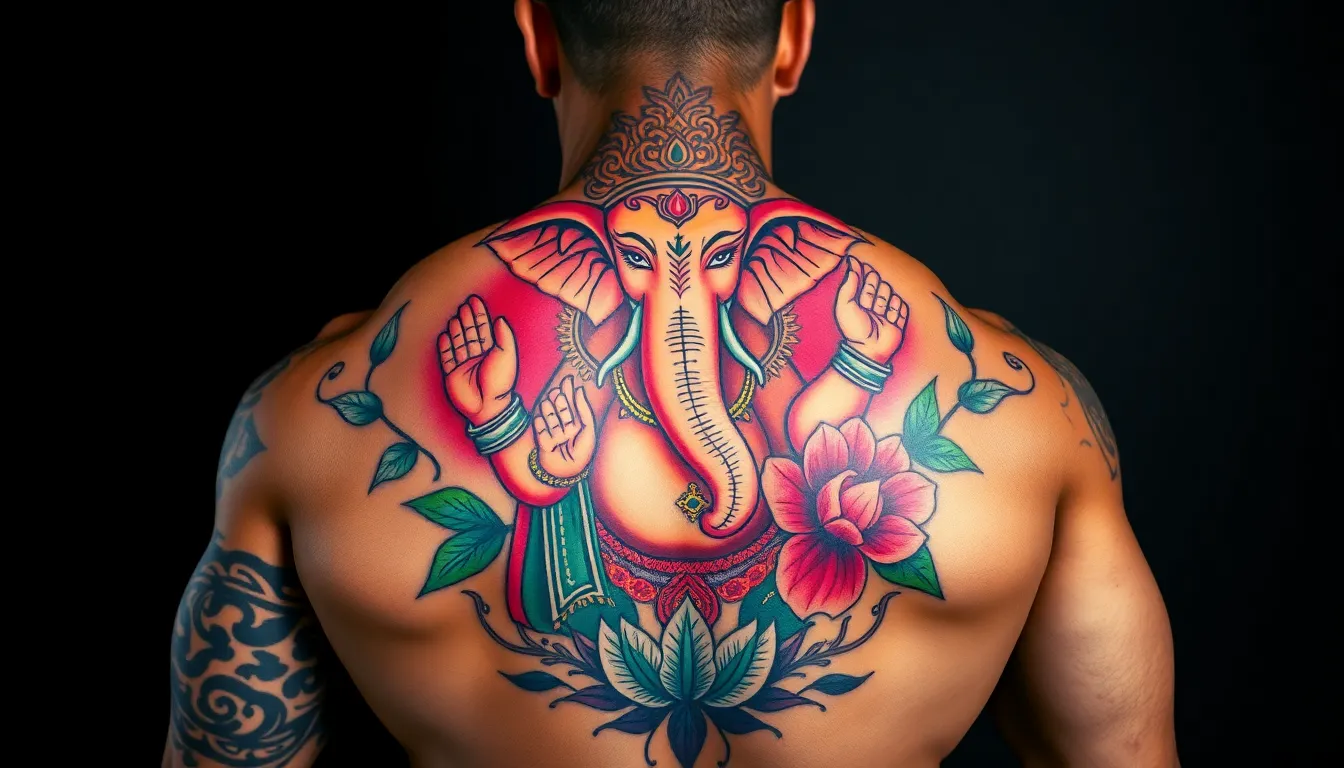
Large scale placements offer men the canvas needed to showcase Ganesha’s intricate details and profound spiritual symbolism. These expansive designs allow artists to incorporate multiple sacred elements while maintaining the deity’s powerful presence.
Back Piece Compositions
Back pieces featuring Ganesha provide the ultimate canvas for detailed artistic expression, utilizing the broad surface area to create stunning spiritual masterpieces. Artists typically position Ganesha’s elephant head as the central focal point, surrounded by intricate lotuses, sacred sweets, and traditional Hindu symbology that enhances the overall spiritual impact.
Complex shading techniques bring depth to these large compositions, while vibrant colors illuminate symbolic elements like mandalas and Om symbols that frame the deity’s divine form. Multiple symbolic attributes such as the axe, modak sweets, and lotus flowers find natural placement across the expansive back area, creating a comprehensive spiritual narrative.
Sacred geometry patterns often extend from Ganesha’s image, incorporating temple architecture elements and other Hindu deities that complement the primary design. We’ve observed that successful back pieces balance detailed realism in Ganesha’s features with flowing decorative elements that unite the entire composition.
Chest Panel Designs
Chest tattoos featuring Ganesha emphasize symmetry and bold outlines, positioning the deity’s powerful presence close to the heart where it symbolizes protection and strength. Artists focus on creating centered compositions that highlight Ganesha’s distinctive elephant face and curved trunk, often incorporating traditional iconography like the Om symbol directly above or below the main image.
Bold line work defines the chest area designs, with Ganesha’s multiple arms extending naturally across the pectoral muscles to create visual balance and spiritual significance. Sacred attributes like the trident, modak sweets, and ritual implements find strategic placement within the chest’s natural contours, improving both aesthetic appeal and symbolic meaning.
Ornamental details such as lotus petals and mandala patterns often frame the central Ganesha figure, creating a harmonious blend of spiritual symbolism and artistic beauty. Color applications in chest pieces typically focus on rich, deep tones that emphasize the deity’s regal nature while maintaining visual impact against the body’s natural skin tone.
Full Sleeve Integrations
Full sleeve tattoos featuring Ganesha blend the deity’s divine image with complementary Hindu mythological elements, creating comprehensive spiritual narratives that flow seamlessly from shoulder to wrist. Artists use the arm’s elongated shape to depict Ganesha in ever-changing poses, often showing the deity in movement or blessing gestures that capture his active role as obstacle remover.
Lotus flowers, mandalas, and sacred geometry patterns weave throughout the sleeve design, connecting Ganesha’s primary image with supporting spiritual symbols that enhance the overall meaning. Ever-changing compositions often incorporate other Hindu deities, temple architecture, and Sanskrit mantras that create layered storytelling within the sleeve’s vertical format.
Color techniques in full sleeve designs frequently combine vibrant traditional hues with black and gray elements, creating contrast and depth that makes each symbolic element distinct while maintaining visual unity. Artists strategically place prosperity symbols and intellectual emblems throughout the sleeve, ensuring that every section contributes to the tattoo’s spiritual significance and artistic impact.
Small and Subtle Ganesha Tattoo Options

Men increasingly choose smaller Ganesha tattoos for their perfect balance between spiritual significance and professional discretion. These compact designs offer meaningful spiritual connections while remaining easily concealed when necessary.
Wrist and Forearm Placements
Wrist Ganesha tattoos serve as daily spiritual reminders that remain visible yet manageable in size. We often recommend these areas for minimalist trunk designs or simple crown symbols that capture Ganesha’s essence without overwhelming detail. The forearm provides slightly more space for intricate elements like small lotus flowers or geometric patterns surrounding the deity’s silhouette.
Popular wrist designs include single-line trunk drawings that curve gracefully around the wrist bone. Forearm placements allow for vertical compositions featuring Ganesha’s profile with subtle mandala accents. Both locations offer easy concealment under long sleeves while providing quick access for personal meditation or reflection.
Behind-the-Ear Designs
Behind the ear placements offer the most discreet Ganesha tattoo option for men seeking highly personal spiritual expressions. These locations work perfectly for small line art interpretations or simplified crown symbols that carry deep meaning without drawing attention. The curved space naturally accommodates abstract trunk designs or minimalist Om symbols combined with Ganesha elements.
Design considerations include fine line techniques that age well in this delicate area. We suggest focusing on Ganesha’s most recognizable features like the distinctive trunk curve or crown outline. Black ink performs best in this placement due to the skin’s thickness and natural healing patterns.
Ankle and Calf Positions
Ankle Ganesha tattoos provide excellent concealment options while allowing for medium-sized spiritual designs. The area accommodates detailed trunk and crown combinations or small seated poses that maintain symbolic integrity. Calf placements offer expanded canvas space for more comprehensive Ganesha representations including his vahana mouse or favorite modak sweets.
Both positions suit men wanting seasonal visibility control through footwear and clothing choices. Ankle designs typically feature circular or oval compositions that follow the bone structure naturally. Calf tattoos can incorporate vertical elements like lotus stems or geometric borders that enhance the overall spiritual narrative while maintaining subtle elegance.
Ganesha Tattoo Designs with Mandala Elements
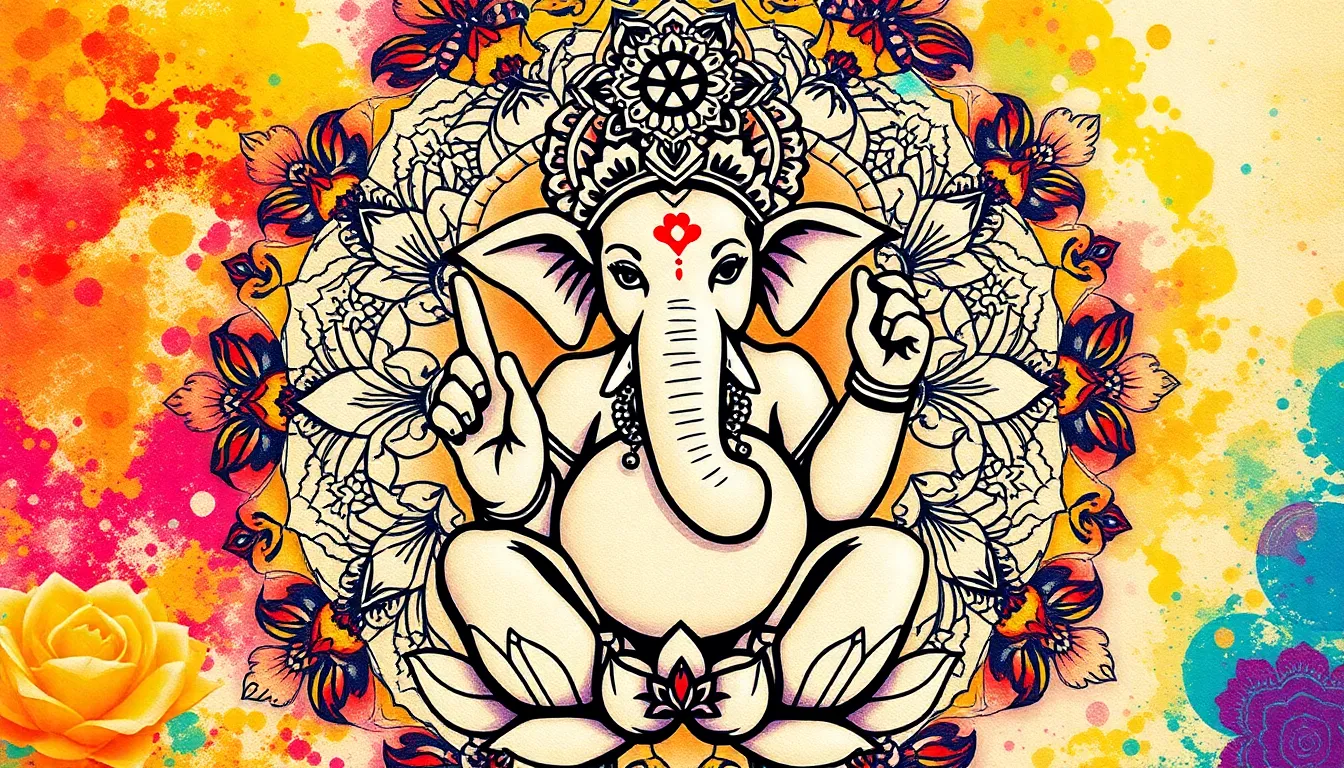
Mandala patterns transform Ganesha tattoos into deeply spiritual masterpieces that combine Hindu symbolism with sacred geometry. These circular designs enhance the divine nature of Lord Ganesha while creating visually stunning artwork that speaks to both the soul and the eye.
Intricate Background Patterns
Lotus flowers serve as the most popular backdrop for Ganesha mandala tattoos, symbolizing purity and spiritual awakening alongside the deity’s wisdom. Paisley motifs weave throughout the design, creating flowing patterns that complement Ganesha’s curved trunk and rounded form. Ornamental filigree adds layers of detail that frame the elephant-headed god with delicate, lace-like patterns.
Artists often incorporate temple architectural elements into the background, featuring carved pillars and ornate doorways that honor traditional Hindu artistry. Water ripples and cloud formations provide movement within the mandala structure, representing the flow of divine energy around Ganesha. Peacock feathers and vine patterns create organic textures that balance the geometric precision of mandala circles.
Sacred Geometry Combinations
Triangular formations surround Ganesha’s figure to represent the harmony between mind, body, and spirit in many mandala designs. Circular patterns radiate outward from the central deity, creating layers of meaning that emphasize cosmic order and universal balance. Symmetrical shapes like hexagons and octagons provide structure while maintaining the flowing energy associated with Ganesha’s benevolent nature.
Mathematical precision guides the placement of geometric elements, ensuring each shape contributes to the overall spiritual message of obstacle removal. Intersecting circles create flower-of-life patterns that enhance the tattoo’s connection to divine creation and infinite wisdom. Square grids anchor the design while allowing organic elements like Ganesha’s trunk and ears to break free from rigid boundaries.
Detailed Ornamental Borders
Traditional bead patterns frame Ganesha mandala tattoos with repeating circular elements that echo prayer malas used in Hindu worship. Floral vine borders incorporate jasmine and marigold motifs, flowers commonly offered to Lord Ganesha during religious ceremonies. Hindu iconography details like conch shells, drums, and lotus petals create borders that tell stories of devotion and spiritual practice.
Rope-like braided patterns provide textural contrast against the smooth curves of mandala geometry while maintaining the tattoo’s cohesive flow. Celtic-inspired knotwork occasionally appears in modern interpretations, representing the eternal nature of Ganesha’s protective influence. Stepped pyramid borders reference temple architecture, grounding the spiritual imagery in physical spaces of worship and meditation.
Color Versus Black and Gray Ganesha Tattoos
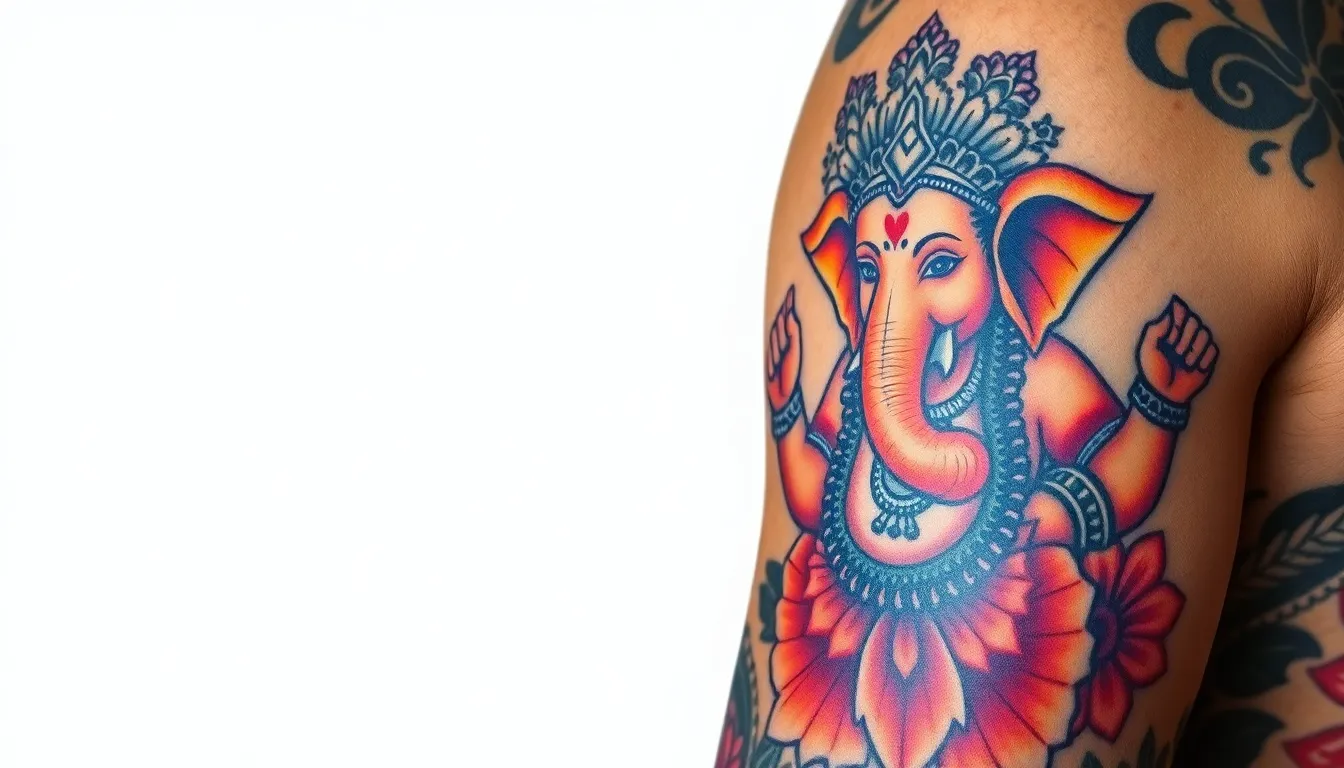
We’ve explored various placement options and mandala elements, but color choices significantly impact the overall spiritual and visual impact of your Ganesha tattoo. Different color approaches offer distinct advantages that appeal to men’s varying preferences and aesthetic goals.
Vibrant Traditional Colors
Traditional colorful Ganesha tattoos celebrate the deity’s divine nature through bright, sacred hues that honor centuries of Hindu artistic tradition. Red, orange, green, and blue create stunning visual impact while highlighting Ganesha’s auspicious qualities and joyful essence. These vibrant colors enhance symbolic elements like lotus flowers, ornate crowns, and decorative jewelry that surround the elephant-headed deity.
Artists often incorporate warm oranges and deep reds to emphasize Ganesha’s association with prosperity and new beginnings. Rich blues and greens highlight his connection to wisdom and spiritual growth. Gold accents frequently appear in traditional designs, symbolizing divinity and sacred power.
Colorful tattoos offer intricate detail possibilities that bring Ganesha’s image to life with exceptional vibrancy. Sacred symbols like the Om, modaks, and lotus petals gain enhanced meaning through traditional color applications. These designs typically require multiple sessions due to their complexity and color saturation requirements.
Monochromatic Shading Techniques
Black and gray Ganesha tattoos focus on sophisticated shading techniques that create depth and texture without relying on color. This approach emphasizes detailed line work and shadow play to capture Ganesha’s facial expressions and intricate patterns. Artists use various shading methods to highlight the deity’s elephant features, trunk curves, and ornamental details.
Monochromatic designs appeal to men who prefer subtle, timeless aesthetics while maintaining powerful spiritual symbolism. These tattoos often showcase exceptional artistic skill through realistic rendering and complex shadow work. The absence of color allows viewers to focus on form, proportion, and intricate details that might otherwise be overshadowed by bright hues.
Gray wash techniques create smooth transitions between light and dark areas, giving Ganesha’s image dimensional quality. Black ink provides bold outlines and deep shadows that emphasize the deity’s commanding presence. This style suits professional environments where subtle tattoos are preferred while preserving spiritual significance.
Selective Color Accent Approaches
Selective color accent techniques combine the elegance of black and gray with strategic color placement to create striking visual contrast. This hybrid approach maintains sophisticated monochromatic foundations while highlighting exact elements like Ganesha’s eyes, sacred symbols, or ceremonial ornaments. Artists carefully choose which details receive color treatment to maximize impact without overwhelming the design.
Popular accent colors include deep red for Ganesha’s tilaka markings, gold for jewelry and crowns, and vibrant orange for lotus petals or religious symbols. These selective applications draw attention to spiritually important elements while preserving the overall subdued aesthetic. The technique works particularly well for men who want colorful highlights without committing to fully colored tattoos.
Balanced color distribution creates visual harmony between monochromatic and colored elements. This approach allows for future color additions if desired, making it an excellent choice for men who might want to expand their tattoo over time. The selective method also tends to age better than fully colored tattoos, maintaining crisp contrast as the ink settles.
Cultural Significance and Respectful Design Choices
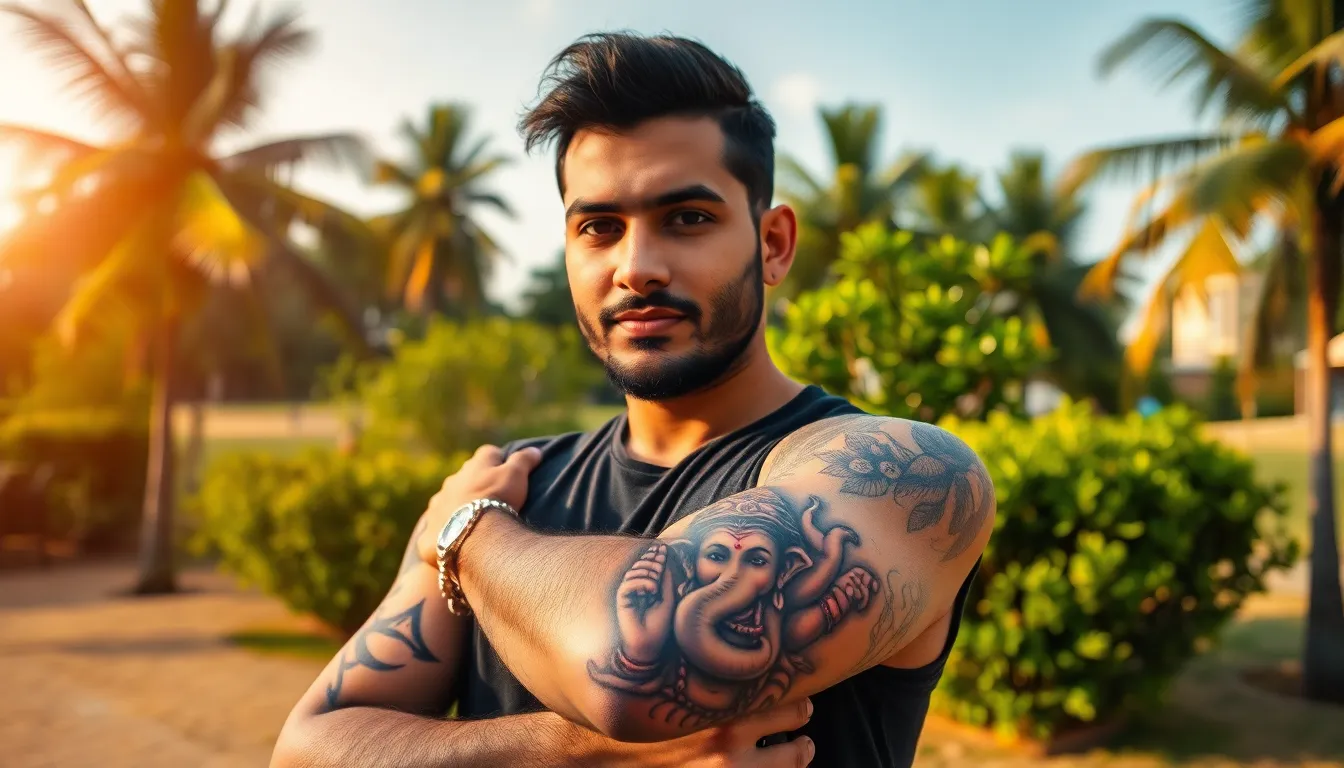
Before we explore the artistic elements of Ganesha tattoos, we must understand the profound cultural responsibility that comes with wearing this sacred symbol.
Understanding Ganesha’s Symbolism
Ganesha represents one of Hinduism’s most beloved deities, serving as the remover of obstacles and the god of beginnings, intellect, wisdom, and success. Our understanding of this symbolism transforms a simple tattoo into a powerful spiritual emblem that reflects faith, devotion, and connection to divine attributes.
Men choose Ganesha tattoos to attract good fortune and blessings while creating a permanent reminder to face life’s obstacles with wisdom and confidence. These designs carry deep meaning beyond their aesthetic appeal, symbolizing wisdom, prosperity, new beginnings, and the ability to overcome challenges in life.
Traditional depictions showcase intricate details that honor centuries of Hindu artistic heritage, while modern interpretations may incorporate vibrant colors or complementary symbols like lotus flowers representing purity. Each element we include should reflect genuine understanding of Ganesha’s divine nature rather than superficial decoration.
Avoiding Inappropriate Placements
Placement decisions require careful consideration of Hindu cultural sensitivities since Ganesha tattoos hold deep religious meaning for millions of devotees. We must avoid disrespectful locations such as the feet or areas considered impure in Hindu culture to maintain the sacred integrity of the design.
Ideal placements include arms, chest, shoulders, and back where the tattoo can be respectfully displayed and properly honored. These locations allow for appropriate sizing while ensuring the deity receives the reverence deserved in Hindu tradition.
Consulting with experienced tattoo artists who understand the symbolism and cultural context helps ensure our design choices reflect personal spirituality while honoring Hindu customs. Artists familiar with religious iconography can guide placement decisions that maintain cultural sensitivity throughout the tattooing process.
Honoring Hindu Traditions
Ganesha tattoos serve as expressions of devotion and respect toward Hindu heritage, requiring us to approach them with genuine reverence rather than purely aesthetic motivations. Wearing a Ganesha tattoo represents a lifelong commitment to the values this deity embodies within Hindu spiritual practice.
Educational preparation becomes essential as we learn about the religious background and symbolism before committing to this sacred design. Understanding Ganesha’s role in Hindu worship, festivals, and daily spiritual practice ensures we honor the culture responsibly while avoiding trivialization of this sacred symbol.
Customizing our tattoo to include personally meaningful elements can deepen our spiritual connection while maintaining respect for traditional Hindu iconography. This balance between personal expression and cultural reverence creates tattoos that serve as powerful emblems of faith and inspiration throughout our lives.
Ganesha Tattoo Design Combinations with Other Elements
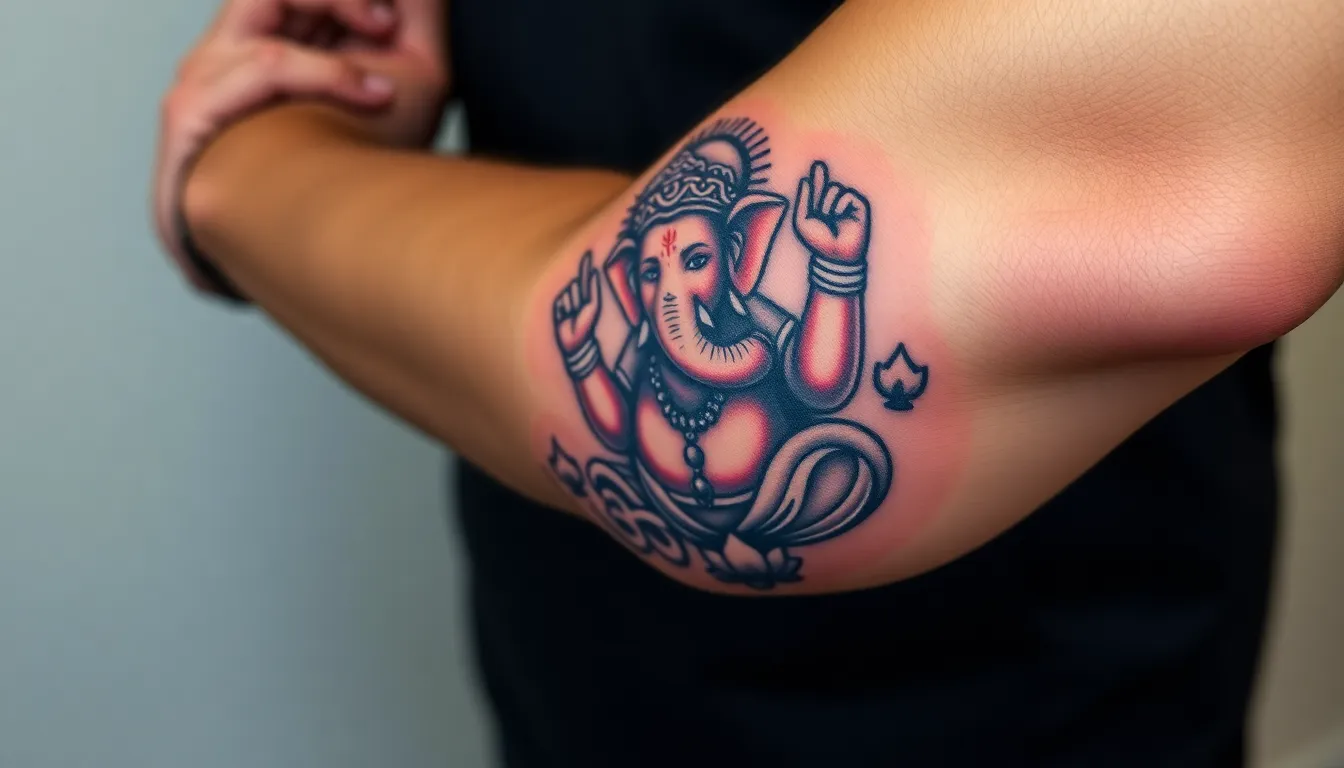
Creating Ganesha tattoos becomes more meaningful when we combine them with complementary sacred symbols and elements. These combinations amplify the spiritual significance while creating visually stunning designs that honor Hindu traditions.
Om Symbol Integrations
Om symbol combinations with Ganesha tattoos create powerful spiritual statements that resonate deeply with Hindu beliefs. The sacred sound symbol, representing divine energy and the universe’s vibration, naturally complements Ganesha’s role as the remover of obstacles. We often see Om symbols positioned above Ganesha’s head like a divine crown or integrated into the background as decorative elements.
Artists frequently place the Om symbol within Ganesha’s trunk curl, creating an elegant flow that connects the deity’s physical form with universal consciousness. Some designs incorporate the Om directly into Ganesha’s body, using the curves and lines to enhance the elephant god’s natural silhouette. These integrations amplify the tattoo’s spiritual resonance while maintaining visual balance.
Modern interpretations blend geometric Om patterns with traditional Ganesha imagery, creating contemporary designs that honor ancient symbolism. The combination invokes Ganesha’s blessings while channeling the Om’s representation of cosmic energy and spiritual awakening.
Lotus Flower Accompaniments
Lotus flowers serve as perfect companions to Ganesha tattoos, symbolizing purity, enlightenment, and spiritual rebirth alongside the deity’s wisdom. Artists commonly position lotus blooms beneath Ganesha’s seated form, creating a throne of spiritual significance that elevates the entire design. The flower’s layered petals provide excellent opportunities for intricate shading and color work.
Background lotus arrangements frame Ganesha beautifully, with petals extending outward to create mandala-like patterns that enhance the tattoo’s visual appeal. We frequently see Ganesha holding lotus flowers in his multiple hands, representing his connection to divine beauty and spiritual awakening. These held flowers can be rendered in detailed realism or stylized to match the overall tattoo aesthetic.
Floating lotus petals around Ganesha create movement and depth, suggesting the continuous flow of spiritual energy and transformation. The combination of lotus and Ganesha symbolizes the journey from material obstacles to spiritual enlightenment, making these tattoos particularly meaningful for men seeking personal growth.
Sanskrit Text Additions
Sanskrit mantras and sacred texts transform Ganesha tattoos into powerful spiritual declarations that invoke the deity’s blessings through ancient language. “Shree Ganeshaya Namah,” meaning “I bow to Lord Ganesha,” represents the most popular mantra addition, typically placed below or around the deity’s image. The flowing script adds elegant typography that complements Ganesha’s curved forms.
Artists often incorporate “Om Gam Ganapataye Namaha,” Ganesha’s seed mantra, which calls upon his power to remove obstacles and grant success. These Sanskrit additions require careful placement to maintain readability while improving the overall design’s spiritual depth. Curved text following Ganesha’s silhouette creates harmony between image and language.
Traditional Sanskrit verses about Ganesha’s attributes can be woven throughout larger tattoo designs, creating comprehensive spiritual narratives. The ancient script’s visual beauty adds cultural authenticity while strengthening the wearer’s connection to Hindu traditions and Ganesha’s divine protection.
Choosing the Right Tattoo Artist for Ganesha Designs
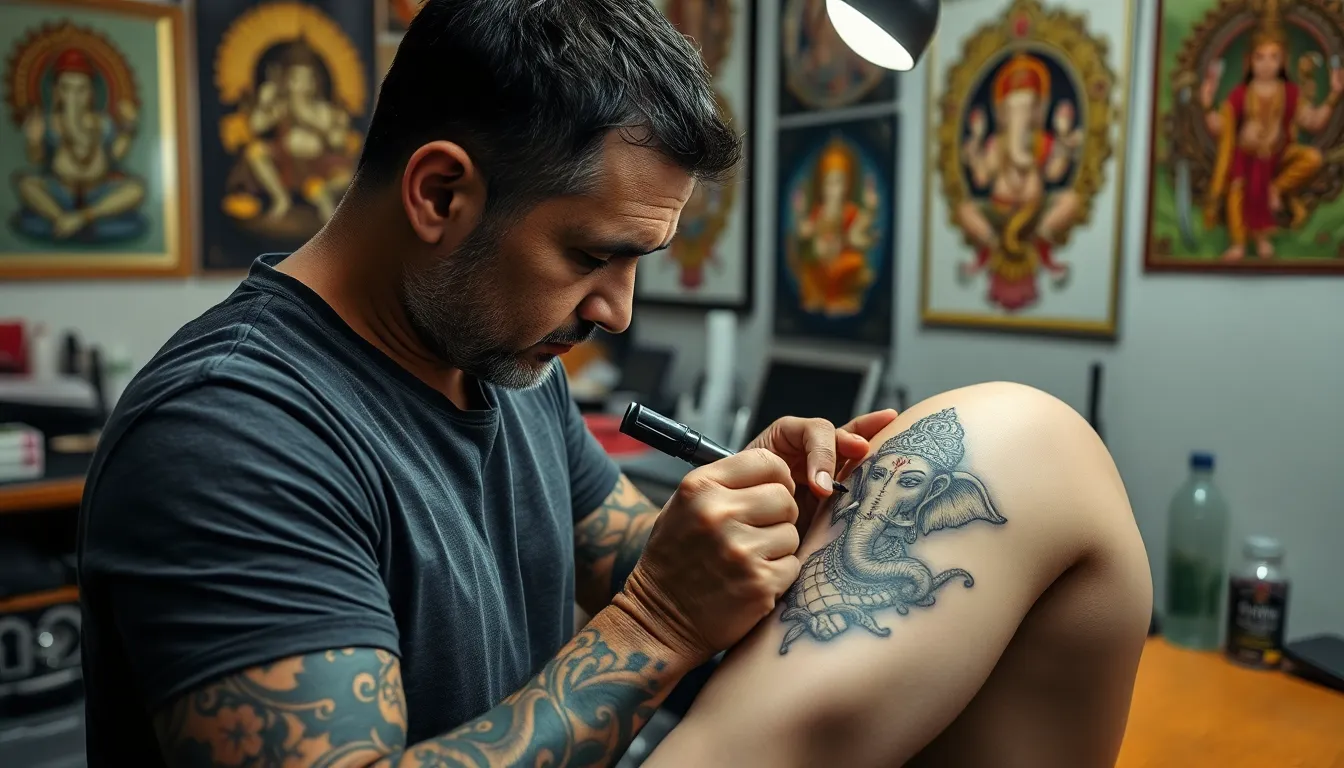
Finding the perfect artist for your Ganesha tattoo requires careful consideration of cultural knowledge, artistic skill, and professional expertise. We’ll guide you through the essential steps to ensure your sacred tattoo is both beautiful and respectful.
Researching Cultural Expertise
Cultural knowledge forms the foundation of authentic Ganesha tattoo artistry. Artists familiar with Hindu iconography understand the spiritual significance behind Ganesha’s elephant head, symbolic hand gestures, and traditional motifs like his beloved mouse companion and sweet offerings called modaks.
Spiritual authenticity matters when selecting an artist who can accurately portray this revered deity’s religious nuances. We recommend seeking tattoo professionals who’ve studied Hindu symbolism and demonstrate genuine respect for sacred imagery rather than treating it as mere decoration.
Traditional elements require precision in their execution, from Ganesha’s distinctive trunk positioning to the intricate details of his four arms and their ceremonial objects. Artists with cultural expertise ensure your tattoo honors the deity’s role as the remover of obstacles and bringer of wisdom.
Portfolio Evaluation Tips
Previous work reveals everything about an artist’s capability to handle complex Hindu spiritual themes. We suggest examining their portfolio specifically for tattoos featuring religious or spiritual subjects, paying close attention to linework precision and color depth.
Detail quality demonstrates skill in managing Ganesha’s intricate design elements. Look for examples showing crisp edges on elephant features, smooth shading transitions, and accurate proportions that maintain the deity’s recognizable characteristics.
Sacred tattoo examples provide insight into the artist’s approach to culturally important designs. Artists who’ve successfully completed Ganesha tattoos often showcase their understanding of proper symbolism placement and respectful artistic interpretation.
Complexity handling shows competence in executing the delicate patterns often associated with Hindu iconography. We recommend evaluating how well previous clients’ tattoos have aged and maintained their spiritual dignity over time.
Consultation Process Guidelines
Initial discussions reveal compatibility between your vision and the artist’s capabilities. We encourage bringing reference images and explaining your personal connection to Ganesha while discussing preferred styles like traditional, modern, or minimalist approaches.
Design collaboration ensures satisfaction through open communication about placement options that complement your body’s anatomy. Professional artists should suggest optimal locations considering both aesthetic appeal and cultural sensitivity requirements.
Process explanation builds confidence in your artist’s professionalism and expertise. They should detail the tattooing timeline, pain management strategies, and comprehensive aftercare instructions exact to your Ganesha design’s complexity.
Cultural respect discussions demonstrate the artist’s commitment to honoring Hindu traditions. We recommend asking about their experience with religious tattoos and their approach to maintaining appropriate reverence throughout the creative process.
Aftercare and Maintenance for Ganesha Tattoos
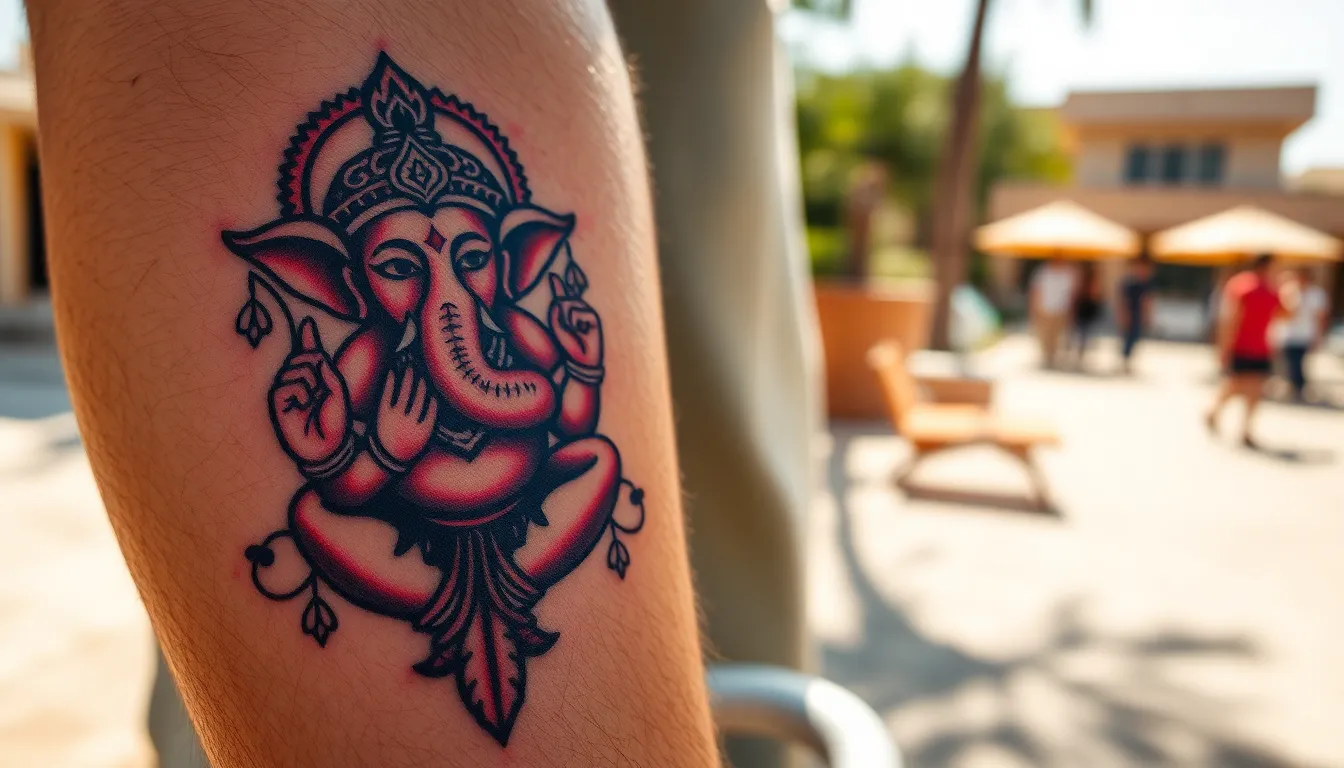
Proper care ensures your Ganesha tattoo maintains its spiritual symbolism and artistic beauty for decades to come. We’ve compiled essential maintenance practices that protect the intricate details and vibrant colors characteristic of these sacred designs.
Initial Healing Protocols
Clean your fresh Ganesha tattoo twice daily with mild, fragrance-free soap and lukewarm water during the first 2-3 weeks. Gently pat the area dry with a clean towel rather than rubbing, which can damage delicate healing skin around intricate mandala patterns or detailed elephant features.
Apply a thin layer of recommended tattoo aftercare ointment or unscented moisturizer to keep the tattooed area properly hydrated. We recommend consulting your artist about exact products that work best with the ink colors used in your Ganesha design.
Avoid direct sunlight exposure completely during the initial healing period to prevent fading of vibrant colors commonly found in traditional Ganesha artwork. Swimming pools, hot tubs, and soaking baths should also be avoided as they can introduce bacteria and cause ink to blur.
Wear loose-fitting clothing over your healing tattoo to prevent fabric from sticking to the skin or irritating the area. This becomes especially important for larger back pieces or chest panel Ganesha designs that cover important surface area.
Never pick at scabs or peeling skin that naturally occurs during healing, as this can result in permanent scarring or color loss in detailed areas like Ganesha’s multiple arms or symbolic items he holds.
Long-term Preservation Methods
Use high SPF sunscreen religiously on your healed Ganesha tattoo whenever it’s exposed to sunlight to prevent fading of intricate details and color saturation. UV rays can particularly damage the fine lines found in lotus flower patterns and mandala elements commonly incorporated into these designs.
Moisturize the tattooed area regularly with quality, unscented lotion to maintain skin elasticity and ink vibrancy over time. Well-hydrated skin helps preserve the sharp lines and detailed features that make Ganesha tattoos so spiritually and artistically compelling.
Avoid abrasive skin treatments such as harsh exfoliation, chemical peels, or aggressive scrubbing directly on the tattooed region. These practices can gradually wear away ink and blur the precise details that give your Ganesha tattoo its sacred significance.
Maintain overall skin health through proper hydration, balanced nutrition, and general wellness practices that support healthy skin regeneration and ink retention throughout your lifetime.
Touch-up Scheduling Considerations
Schedule a consultation with your original artist approximately 6-12 months after your initial Ganesha tattoo session to assess whether touch-ups are needed. Complex designs featuring multiple symbolic elements often require minor adjustments as the skin fully settles and ink stabilizes.
Expect potential touch-ups for fine line work such as Sanskrit text, intricate trunk details, or delicate lotus petals that may experience slight fading or blurring during the healing process. These refinements help maintain the spiritual authenticity and visual impact of your sacred design.
Plan for color refreshing sessions every few years if your Ganesha tattoo incorporates vibrant traditional colors, as certain pigments naturally fade over time even with proper care. Professional touch-ups restore the original intensity and ensure your tattoo continues representing the deity’s divine attributes effectively.
Document your tattoo’s appearance with regular photos to track any changes in clarity or color saturation, making it easier to discuss exact areas that might benefit from professional enhancement during artist consultations.
Conclusion
Ganesha tattoos represent a powerful fusion of spiritual devotion and artistic expression that resonates deeply with men seeking meaningful body art. Whether you’re drawn to traditional designs steeped in Hindu heritage or modern minimalist interpretations these sacred symbols offer endless possibilities for personal customization.
The key to a successful Ganesha tattoo lies in understanding its cultural significance and working with an artist who respects the deity’s sacred nature. From discreet wrist placements to elaborate back pieces each design serves as a permanent reminder of wisdom strength and the removal of life’s obstacles.
By choosing thoughtful placement honoring traditional symbolism and maintaining proper aftercare your Ganesha tattoo will continue to inspire and protect you throughout your spiritual journey. Remember that wearing Lord Ganesha’s image is both a privilege and a responsibility that connects you to centuries of divine tradition.
Frequently Asked Questions
What is the spiritual significance of Ganesha tattoos for men?
Ganesha tattoos represent powerful spiritual symbols of wisdom, prosperity, and the removal of obstacles. As a beloved Hindu deity, Ganesha symbolizes new beginnings and divine guidance. These tattoos transform into meaningful spiritual emblems that provide daily reminders of faith, inner strength, and protection throughout life’s journey.
What are the most popular Ganesha tattoo styles available?
Popular Ganesha tattoo styles include traditional Indian motifs featuring authentic Hindu artistic elements, modern minimalist line art designs, geometric patterns, and abstract watercolor interpretations. Each style caters to different aesthetic preferences while maintaining the deity’s sacred symbolism, from intricate detailed compositions to simple flowing line work.
Where are the best placements for Ganesha tattoos on men?
Ideal placements include large-scale options like back pieces, chest panels, and full sleeves for detailed designs. Smaller, discreet options work well on wrists, forearms, behind the ear, ankles, and calves. The placement should respect Hindu cultural sensitivities while allowing for proper display of this sacred imagery.
How can I customize my Ganesha tattoo design?
Customization options include incorporating sacred symbols like Om, lotus flowers, Sanskrit mantras, and ritual objects such as modaks and trishuls. You can blend traditional elements with personal meaningful symbols, choose different artistic styles, and integrate complementary Hindu iconography while maintaining respect for the deity’s authentic representation.
What should I consider when choosing a tattoo artist for a Ganesha design?
Choose an artist with demonstrated cultural knowledge of Hindu traditions and experience with religious tattoo themes. Review their portfolio for previous sacred artwork, ensure they understand Ganesha’s symbolism, and engage in thorough consultation. The artist should show respect for cultural sensitivities and accurately portray spiritual elements.
How do I properly care for my Ganesha tattoo?
Initial care includes cleaning with mild soap, applying prescribed aftercare ointment, and avoiding direct sunlight and water exposure during healing. Long-term maintenance requires regular moisturizing, high SPF sunscreen protection, and periodic touch-ups with your original artist to preserve ink vibrancy and symbolic integrity.
Can Ganesha tattoos be combined with other spiritual symbols?
Yes, Ganesha tattoos beautifully combine with other sacred symbols like Om for cosmic resonance, lotus flowers for purity and enlightenment, and Sanskrit mantras for spiritual declarations. These combinations amplify the tattoo’s spiritual significance while creating comprehensive expressions of faith and cultural authenticity.
Are there cultural considerations when getting a Ganesha tattoo?
Absolutely. It’s essential to understand Hindu traditions and Ganesha’s religious significance before committing to the tattoo. Avoid inappropriate placements that may disrespect cultural sensitivities, ensure designs reflect genuine spirituality rather than superficial decoration, and approach the tattoo with reverence for its sacred meaning.

